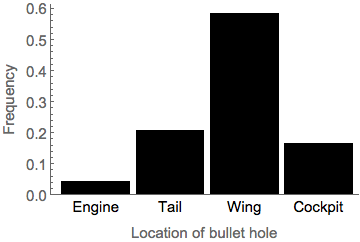Reinforcements
 WWII was the golden age of the dogfight, when enemies would lock their airforces in plane-to-plane aerial combat. Unsurprisingly, many planes were lost to crashes. If a bullet strikes a plane in a sensitive area, it's hard to make it back to base. For the planes that did come back, the mechanics kept track of the location of bullet holes in the fuselage, so that they could reinforce the planes in the vulnerable locations.
WWII was the golden age of the dogfight, when enemies would lock their airforces in plane-to-plane aerial combat. Unsurprisingly, many planes were lost to crashes. If a bullet strikes a plane in a sensitive area, it's hard to make it back to base. For the planes that did come back, the mechanics kept track of the location of bullet holes in the fuselage, so that they could reinforce the planes in the vulnerable locations.
Suppose that for American planes, the bullet holes on returning planes were distributed as follows:

Where should the mechanics reinforce planes so that more of them come back safely?
This section requires Javascript.
You are seeing this because something didn't load right. We suggest you, (a) try
refreshing the page, (b) enabling javascript if it is disabled on your browser and,
finally, (c)
loading the
non-javascript version of this page
. We're sorry about the hassle.
The key here is: If a bullet strikes a plane in a sensitive area, it's hard to make it back to base.
The graph shows a return rate of planes with various location of bullet holes. We'd expect the location of bullet holes in WWII to be fairly even across different parts of the plane, so since an engine failure has the lowest return rate, the engine should have the highest reinforcement.